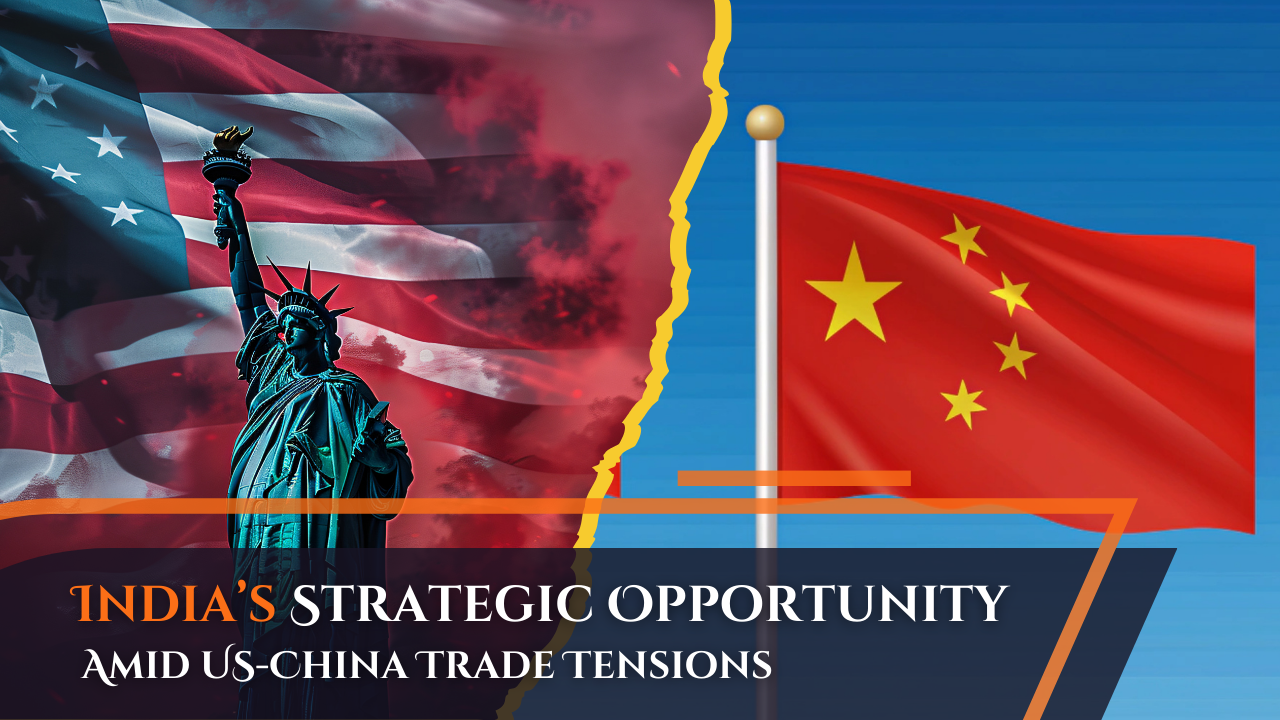India’s Strategic Opportunity Amid US-China Trade Tensions: Leveraging Mineral Diplomacy
Introduction
The intensifying trade war between the United States and China has reshaped global supply chains, particularly in the critical minerals sector. China’s dominance in rare earth elements has allowed it to weaponise its control over critical minerals, restricting exports as leverage in geopolitical conflicts. This has alarmed nations dependent on Chinese minerals, particularly the US and its allies, who now seek alternative suppliers. India, with its recently discovered lithium reserves in Jammu and Kashmir and potential for gallium production from bauxite processing, is in a prime position to fill this gap.
As a member of the Quad (US, Japan, Australia, India), India can use mineral diplomacy to strengthen its economic influence, reduce China’s monopoly on rare earths, and integrate itself into high-value global supply chains. However, realising this opportunity requires overcoming technological, environmental, and geopolitical hurdles, as well as implementing sustainable mining and refining policies.
US-China Trade Tensions and Their Impact on the Global Minerals Market
Trade relations between the US and China have been strained for years, particularly since Donald Trump’s presidency, when the US imposed high tariffs on Chinese imports. In response, China leveraged its control over rare earth elements (REEs) and critical minerals to retaliate against US trade policies. These minerals are essential for semiconductors, clean energy, defence technology, and consumer electronics, making them indispensable to modern economies.
- 2023: China introduced export controls on rare metals vital for high-tech industries and military applications.
- 2024: China halted shipments of gallium, germanium, and antimony to the US, severely disrupting the global semiconductor and defence industries.
- 2025: China restricted the transfer of knowledge related to lithium and gallium processing, making it difficult for other nations to develop their own refining capabilities.
With China controlling nearly 70% of global rare earth mining and 85% of rare earth refining, these restrictions have created severe supply chain vulnerabilities. Western nations, particularly the US, Japan, and European countries, are now searching for alternative suppliers—a scenario that presents a golden opportunity for India to emerge as a key player in the global minerals market.
India’s Key Mineral Assets: Lithium and Gallium
India’s rich reserves of lithium and potential for gallium production present a significant opportunity to strengthen its position in the global mineral supply chain. As China dominates the refining and export of these critical minerals, India has the chance to reduce dependence on imports, boost domestic industries, and emerge as a reliable supplier for global markets. However, realising this potential requires strategic planning, investment, and sustainable practices.
Lithium Reserves in Jammu and Kashmir: The discovery of 5.9 million tonnes of lithium reserves in Jammu and Kashmir marks a turning point for India’s industrial growth and energy security. Lithium is a key component in electric vehicle (EV) batteries, renewable energy storage, and high-tech electronics. Currently, China refines nearly 60% of the world’s lithium, controlling global battery supply chains. Developing India’s lithium extraction and refining industry could help challenge China’s dominance and create new economic opportunities. By investing in lithium mining and refining, India can strengthen its EV and clean energy sectors, reducing reliance on imported batteries while promoting domestic manufacturing.
A well-developed lithium industry would also attract foreign investment and technology partnerships, particularly from countries seeking to diversify their mineral supply chains. Additionally, India’s role in the Quad alliance with the US, Japan, and Australia could facilitate strategic cooperation in critical minerals, enhancing its geopolitical influence. Despite its economic potential, lithium mining poses serious environmental risks, particularly due to its high water consumption and potential for soil degradation. To mitigate these risks, India must adopt eco-friendly extraction techniques and enforce strict environmental regulations. Encouraging battery recycling and developing efficient lithium recovery technologies can also help minimise environmental damage while ensuring a more sustainable supply of this critical mineral for the future.
Gallium Production from Bauxite Processing: Gallium, a vital metal for semiconductors, aerospace, and defence technology, is another resource where India can play a strategic role. Currently, China dominates global gallium production, creating supply vulnerabilities for many advanced industries. However, India has a significant aluminium industry, and gallium can be extracted as a byproduct of bauxite refining.
With the right policies and investments, India can establish itself as a key alternative supplier in the global semiconductor market. At present, India lacks advanced gallium refining facilities, limiting its ability to compete with China. To address this, India must collaborate with technologically advanced nations such as the US and Japan, investing in research and development to build refining expertise. Strengthening gallium production would not only support global semiconductor supply chains but also position India as a key player in emerging technologies, enhancing its industrial and strategic importance worldwide.
India’s Strategic Role in the Quad’s Mineral Cooperation
India’s membership in the Quad—alongside the US, Japan, and Australia—offers a crucial opportunity to strengthen its position in the global mineral supply chain. With rising concerns over China’s dominance in critical minerals, Quad nations are seeking alternative suppliers to secure their industrial and technological needs. India, with its vast lithium reserves and potential for gallium production, can position itself as a key player by expanding its mining and refining capabilities to support these nations.
Bilateral Agreements and Investment Opportunities: To capitalise on this opportunity, India must establish bilateral agreements with Quad partners for mineral exploration, refining, and supply chain integration. These agreements could provide access to advanced mining technologies and facilitate joint ventures that accelerate domestic production. Additionally, by creating a favourable investment climate, India can attract foreign capital to develop its lithium and gallium industries, reducing dependence on imports while boosting local manufacturing and job creation.
Strengthening Supply Chain Resilience: As global industries push for diversified mineral sourcing, India can enhance its role by actively participating in Quad-led initiatives on supply chain resilience. Collaborating with the US, Japan, and Australia would not only secure reliable supply routes but also integrate India into high-value industries such as battery manufacturing, semiconductors, and renewable energy. This strategic positioning would reinforce India’s global standing as a trusted mineral supplier, reducing vulnerabilities associated with China’s market control.
Technology Access and Long-Term Growth: A formal strategic minerals partnership within the Quad could unlock access to cutting-edge extraction and refining technologies, accelerating India’s industrial and economic progress. Investing in research and development, alongside partnerships with advanced economies, would enable India to refine minerals more efficiently and sustainably. By leveraging its mineral wealth and geopolitical alliances, India can transform into a global hub for critical minerals, strengthening its economic security and international influence.
Challenges: Environmental, Technological, and Geopolitical Hurdles
While the potential benefits are significant, India faces the following critical challenges in becoming a leading supplier of lithium and gallium:
- Environmental and Sustainability Concerns
Mining and refining lithium and gallium require intensive water use, chemical processing, and energy consumption, leading to deforestation, ecosystem destruction, and toxic waste generation. If not managed properly, mining operations could cause irreversible damage to local communities. India must:
- Implement strict environmental regulations and enforce responsible mining practices.
- Invest in green mining technologies that reduce waste and energy consumption.
- Develop battery recycling infrastructure to reduce demand for newly mined lithium.
- Technological Barriers and Infrastructure Deficiency
India lacks the refining and processing infrastructure necessary to produce battery-grade lithium and semiconductor-grade gallium. Without investment in advanced refining technology, India risks remaining a raw material exporter rather than a high-value supplier. To address this, India must:
- Accelerate R&D in lithium and gallium refining technologies.
- Partner with Quad nations to facilitate technology transfer.
- Offer incentives to private companies to invest in refining infrastructure.
- Geopolitical Considerations and Economic Balancing Act
While closer economic ties with the US and Quad nations will benefit India, completely cutting ties with China could invite economic retaliation. China remains one of India’s largest trading partners, and a sudden shift in mineral policy could disrupt other critical trade sectors. India must:
- Adopt a phased approach to supply chain diversification to reduce reliance on China without provoking economic backlash.
- Maintain open diplomatic channels with Beijing to prevent trade conflicts.
- Expand trade partnerships beyond the Quad, ensuring a diversified global market.
Conclusion:
The US-China trade war and China’s increasing mineral export restrictions have presented India with a once-in-a-generation opportunity to establish itself as a global leader in critical minerals. By leveraging its lithium and gallium resources, investing in refining capabilities, and forging strategic partnerships with the Quad, India can:
- Strengthen its global economic and industrial position.
- Reduce dependency on Chinese minerals and enhance global supply chain resilience.
- Boost domestic industries in EVs, semiconductors, and clean energy.
However, this will require sustainable mining practices, infrastructure development, and careful diplomatic balancing. If India successfully navigates these challenges, mineral diplomacy could become the foundation of its rise as a global economic and geopolitical powerhouse in the 21st century.
Subscribe to our Youtube Channel for more Valuable Content – TheStudyias
Download the App to Subscribe to our Courses – Thestudyias
The Source’s Authority and Ownership of the Article is Claimed By THE STUDY IAS BY MANIKANT SINGH




